The Surface 3 Review
by Brett Howse on May 4, 2015 9:00 AM ESTGPU Performance
The Surface 3 with the Atom x7-Z8700 pairs the Intel Gen 8 Graphics from Broadwell with the Airmont CPU cores of Atom. Unlike the Broadwell cores though, the Surface 3 SoC only has 16 execution units (EUs) as compared to 24 in Core M. The maximum frequency is also reduced to 600 MHz for these cores, as compared to up to 900 MHz in Core M. This is all necessary to keep the x7-8700 in the 2 watt SDP.
So performance will be a step back compared to Core M, but really this should be no surprise. The interesting comparison will be how it compares to Surface Pro 3 with Haswell Gen 7.5 graphics and of course to Bay Trail equipped tablets.
We will start with some synthetic tests and then move on to DOTA 2 to see how it performs on a real world game.
3DMark Tablet
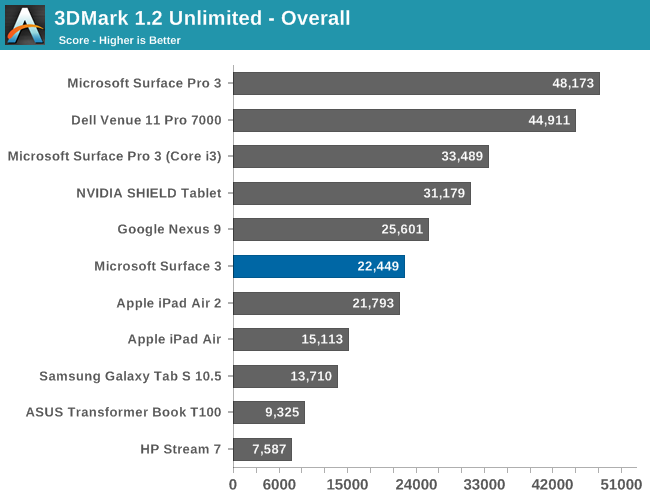


The GPU upgrade is a big improvement over the ASUS T100's Bay Trail graphics, but the Atom GPU still can not compete with the fastest tablet SoCs out there.
3DMark Notebook
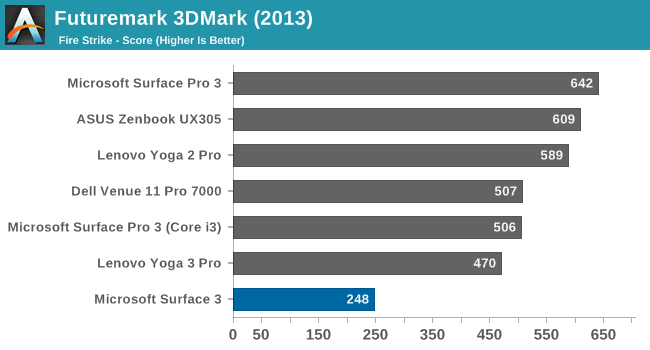
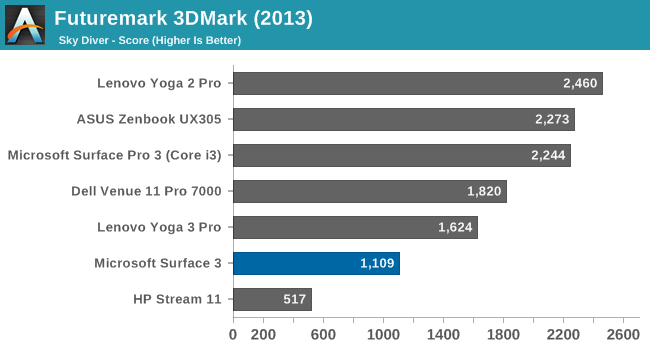
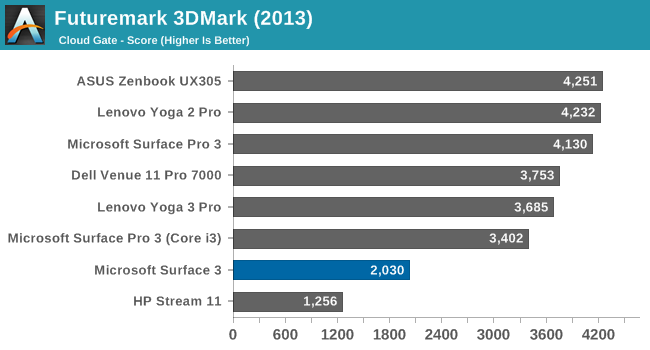

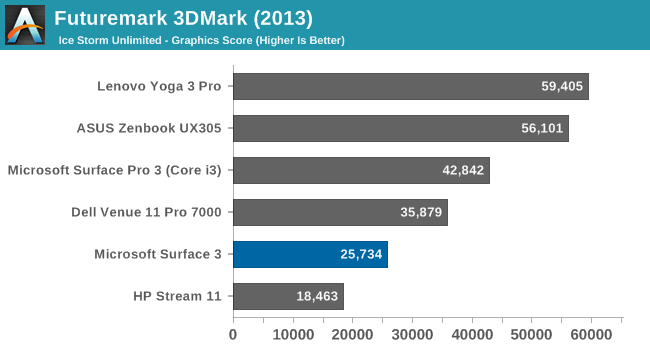
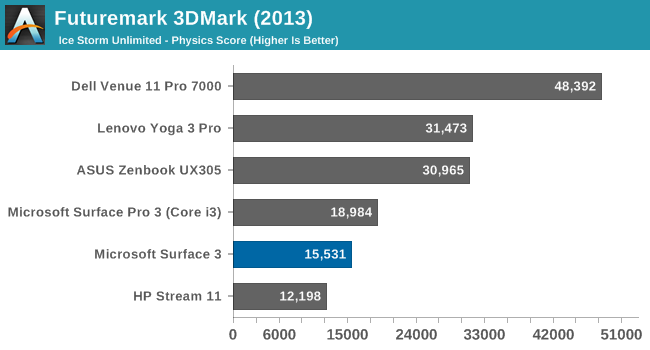
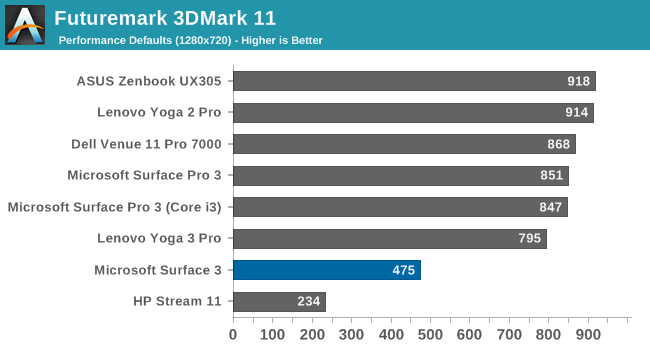
Comparing the Surface 3 to PC class hardware puts it in a pretty poor light when looking at GPU performance. Our 3DMark tests have the Surface Pro 3 with the Core i3 on average 40% faster than Surface 3. Comparing it to the Dell Venue 11 Pro with Core M, we find the Core M GPU is on average 47% faster, which is quite a gap. Let’s not forget though that the Surface 3 is a mere 2 watt SDP, whereas Core M is a 4.5 W TDP and the Haswell-Y in Surface Pro 3 is an 11.5 W TDP.
GFXBench Tablet (OpenGL)
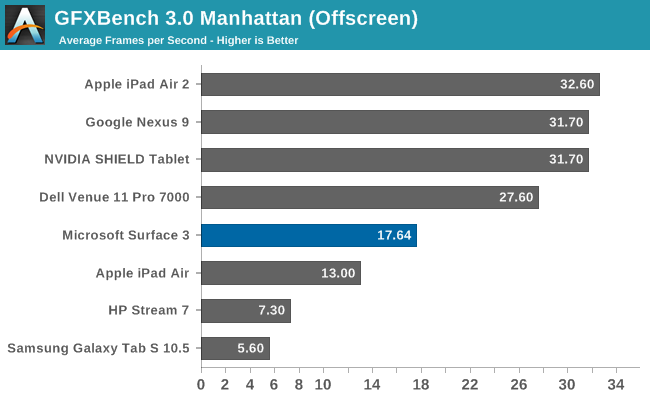
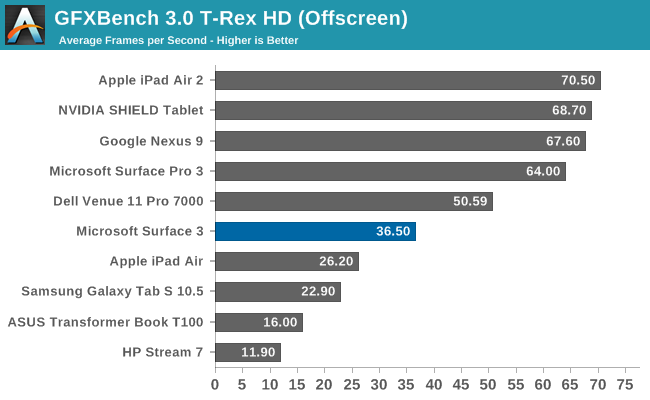
As with the 3DMark scores, the GPU upgrade is significant, but still a ways back of the best tablet GPUs out there. Intel still has some work to do on this front.
GFXBench Notebook (DirectX)
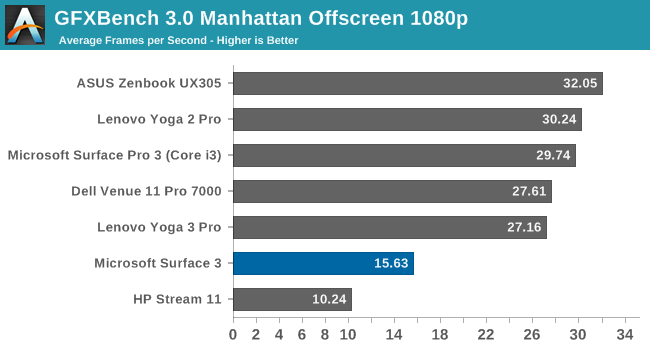
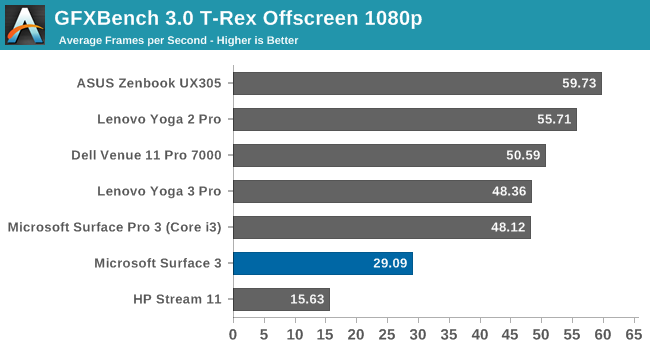
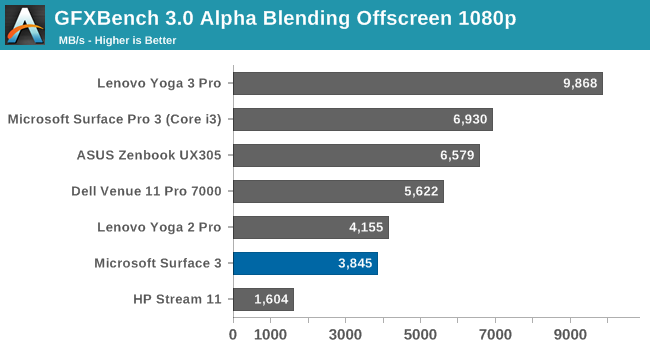

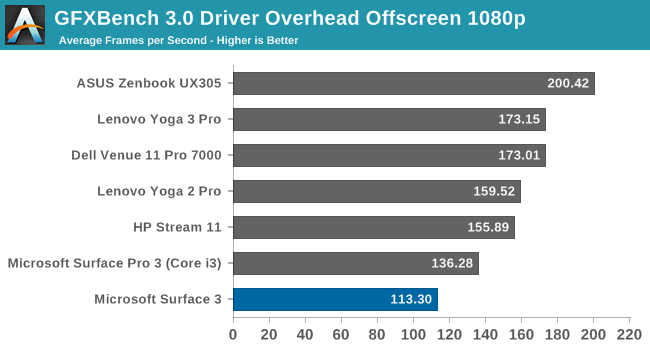
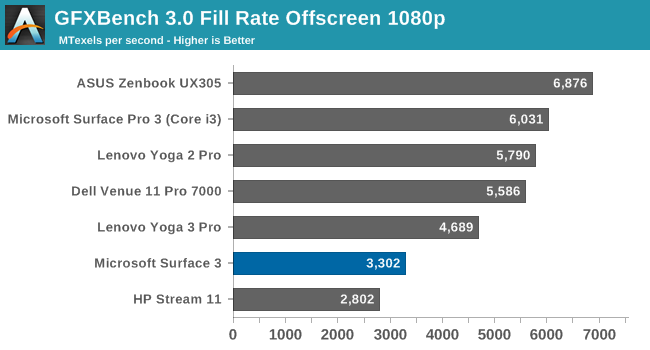

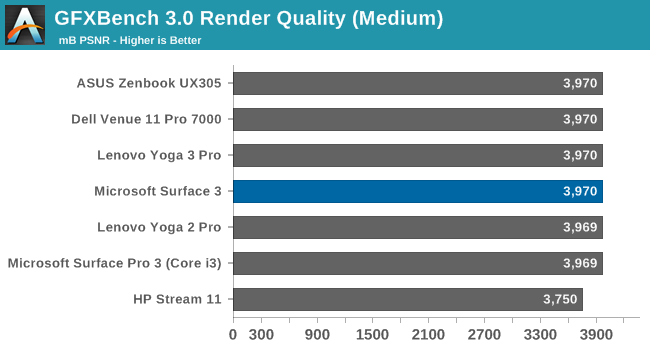
We see a similar story with GFXBench on the notebook side. The 16 EUs in our Atom SoC just cannot compete against the larger and faster GPUs in Core.
Moving on to a real-world game, we use a custom DOTA 2 benchmark for our lower powered devices. It is a very popular battle-arena game, and the GPU requirements are not too demanding.
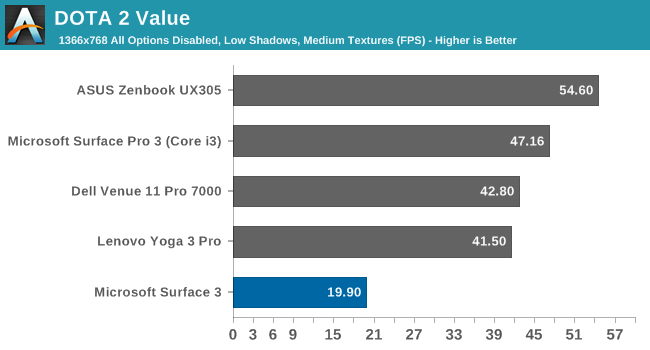
The GPU in the Surface 3 is really not enough to play most games, and even on our value settings, the Surface 3 is not a great experience for DOTA 2. The higher TDP of Core M lets it do ok in this test, but overall the Surface 3 is a long way back of even the Surface Pro 3 Core i3.
Storage Performance
Like most tablets, the Surface 3 utilizes eMMC storage rather than the SSD storage found on higher priced laptops and Core M tablets. It costs less, it is less complex, and it works. So expectations are that it will not be able to compete with the fastest solutions out there. But as a tablet, workloads should be less complex, at least in theory.
Unfortunately Microsoft shipped me the 64 GB version of the tablet, and due to PCMark 8 requiring a large amount of free space in order to perform its tests, it was unable to be run on this device. But we have run into this issue in the past, and we can turn to a couple of other tools to get a feel for how the storage performance is. Even though eMMC is slower than a good SSD, there is still different levels of performance based on the NAND in use and the controller.
I ran CrystalDiskMark over a 4 GB span and the results are below.
Surface 3 eMMC Storage (left) vs Surface Pro 3 Core i3 SSD (right)
Compared to a true SSD, the eMMC performance leaves a lot to be desired. In fact, most of the time when I was using the tablet and I found it slow, such as installing software, or loading programs, it was mostly disk bound. There are faster eMMC options available, but I will refrain from comparing it to other tablets since we do not have the same benchmarking tools for both.


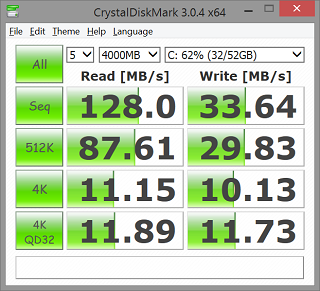
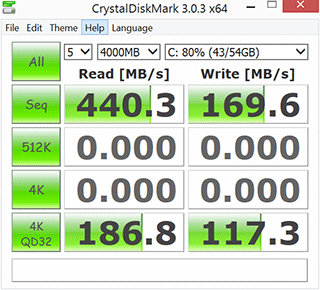








265 Comments
View All Comments
MrSpadge - Monday, May 4, 2015 - link
Using legacy apps (which are still called programs) should be fine with the pen. Except for the high DPI display - depending on how legacy the app exactly is.Alexvrb - Monday, May 4, 2015 - link
It runs touch-friendly modern apps (including Universal apps which will be getting a boost in the near future) as well as more traditional software. You can use just about any external accessory that you can with a regular PC. If you use the dock and a larger monitor this can even replace the desktop for many users. In many ways it is more versatile than the devices you mentioned.stephenbrooks - Saturday, May 9, 2015 - link
Actually a lot of programs designed for mouse input (click and drag) work pretty well on a touchscreen Windows machine. The main problem is the buttons tend to be too small for fingers.It would be great if Microsoft could have an option to magically enlarge GUI elements a bit when in touch mode.
jaydee - Monday, May 4, 2015 - link
When I say lack of apps, I mean as designed as portable tablet. That's what MS is touting, it's a tablet and laptop in one.Of course it has tons of apps as a Win8/10 device, but if that's all you're really after, why buy something that straddles the line between laptop and tablet? Why not an XPS 13 or Spectre x360? Proportionally few of those Windows apps tend to run real well on a 10" touch screen with a resolution of 1920x1280.
It just seems to be in an odd place. I'm not sure what it does really well, other than its display. CPU/RAM/SSD are all compromised as a laptop and it's too expensive for what it does as a tablet. It's not "bad" by any means, I really do *want* to like it, it just doesn't seem to do the laptop thing well enough, be a tablet at a low enough price point. And I'm someone who would like to replace my iPad Air with something convertible like this. But if I'm going to buy a laptop that can also be used as a tablet, it's either going to have to have higher performance, or be cheap enough to not feel bad replacing in a couple years, and I don't feel either with this (particularly with accessories). I'm much more apt to get the i5/8GB/256GB HP Spectre x360 @$1,000, while more expensive, I feel much better about thinking about using for the next 5 years, compared to the Surface $600 + type cover + dock @ $930 and still has a tablet mode. The Surface Pro 3 is nice, but I'm not sure what it offers over the Spectre x360, at a sales price of ~$1,130 (retail $1,300), not to mention being a gen behind with Haswell still. If history is any indication, I will like the SP4 as a product, but probably not at it's price point.
Impulses - Monday, May 4, 2015 - link
If the base model included 4GB and/or they at least threw in the pen for free with certain combos, it'd be more enticing. It's still an attractive package for people who just want a secondary system, but a lot of those are just gonna end up with cheaper tablets or more capable laptops.Even tho it's significantly cheaper than SP3, and it's exactly what a lot of people said the base Surface should've been all along, it still feels like less of a value proposition than SP3. Better storage and Type C might've made it more appealing...
As it is it feels too much like something they'll refine significantly for the next rev... Big EDU discounts could sway things tho. A simple $100 student discount would make it a $530-630 hybrid competing against $400-500 tablets and $750+ laptops, much better sweet spot.
simard57 - Thursday, May 7, 2015 - link
Costco has a bundle that includes keyboard and pen for $100 more over the 2GB and 4GB modelsillegaloperation - Monday, May 4, 2015 - link
How much is portability worth to you?The HP Spectre x360 weigh over twice that of the Surface 3.
Also, why is the Dock being factor into the price? The Dock is nice to have, but it's hardly essential.
The0ne - Monday, May 4, 2015 - link
Just curious, what apps are you missing one the Windows platform? For someone like me who would use this for work, I can't imagine an app that is not available that I would use. You mean it doesn't have the hundreds and thousands of useless apps that are in all markets? Always confused by this statement.jaydee - Tuesday, May 5, 2015 - link
In order for it to be considered a good "tablet", it has to do all those things that tablets are known for. Apple and Android have this tremendously large ecosystem that many people are vested in and there's a huge selection for. Obviously "entertainment" apps are going to be useless for people who use this for work. Just like the "productivity" apps aren't useful for those who use it for entertainment, etc. Certainly, the Windows tablet is a better match for a certain type of productivity user like yourself, then a gamer per se. What a tablet has come to be, for many people though is a ubiquitous device that transcends both genres and I don't see that in the Windows platform. Not to mention the fact that Apple/Android tablet users are going to have a hard time switching over if they've invested a decent amount of money into their Apple/Android apps.Like I said, I really want to like this device, but it just feels like too many compromises as a laptop and a mixed bag as a tablet. Does that mean that it's not a great device for some people? Absolutely not! I just don't see it doing one (laptop) or the other (tablet) well enough to break through mainstream and be a big seller at this price point. As other people have mentioned, if it were a lower price or included accessories or faster storage or Core-M instead of Atom were here, I would probably feel much different, but it's too many compromises as is.
Gigaplex - Monday, May 4, 2015 - link
With Windows 10, Microsoft is aiming to bridge the "App gap" by making porting of iOS and Android apps to Windows fairly trivial.